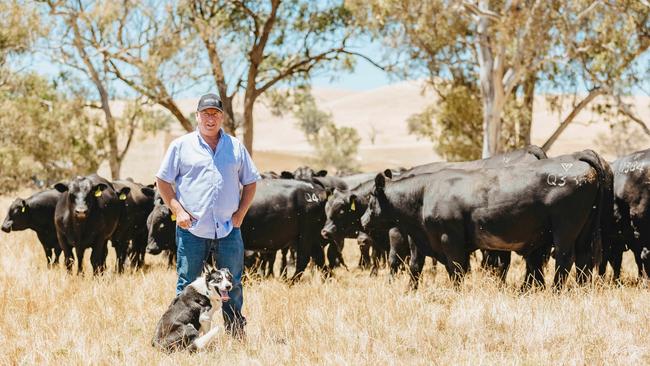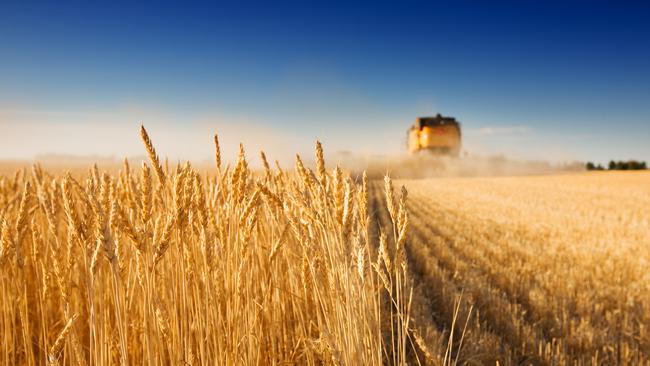Agriculture emissions: Farmers join fight to halt climate change
Disorder on a large scale is inevitable when the supply of food stops. Meet the Aussie farmers working to protect our supply chain.

Food is important.
So much so, Britain’s security agency MI5 believes the nation is only “four meals away from anarchy”.
This maxim speaks to one simple idea: disorder on a large scale is inevitable when the supply of food stops. This may feel like an exaggeration, but history shows when food is unavailable – or simply too expensive – it pushes people to the brink.
Food production and farming is also a way of life for regional families and communities. After all, someone has to rear the livestock, which turns into steak. Someone has to harvest the grain, which becomes the bread for your sandwich. And cattle need milking before pouring a latte.
But producing enough calories to feed the world is a difficult task. A task threatened more and more by changing eating habits, and a global climate challenge. Arable land across Australia could become impossible to farm. But attempting to make profound changes to the way we farm and how we eat is an emotional endeavour. One tied up in personal choice and cultural practices. It’s complex. But it’s a topic that needs to be discussed. After all, the future of our food is at stake.
Why should Australian farmers care about climate change?
The next generation cares about it, that’s why.

Lawsons Angus stud principal Harry Lawson says it was a confronting conversation with his children that forced him to take a look at how he was running his farm.
“About five years ago, the kids were coming home from school and my daughter Charlotte tells me how we’re ruining the planet,” Lawson says. “They were asking me how much water are we using? And I couldn’t answer their questions. I didn’t have the right response.
“I could see that momentum. That’s when I started researching more.”
Lawsons Angus, at Yea in North East Victoria, now runs what the family calls a “Low Carbon Beef” operation. Using genetics and farming practices such as herd management and measured feed intake, the Lawsons produce quality beef that reaches maturity as efficiently as possible with low emissions.
There are plenty of other industries emitting more greenhouse gases, such as the energy sector, but agriculture does contribute. A federal government emissions report put agriculture’s total emissions in 2018-19 at 85.6Mt of carbon dioxide, compared to the 178.5Mt of CO2 emitted by the electricity sector alone. And the agriculture sector reduced emissions by almost five per cent during that 12-month period.
But the consequences of easing up now could change what farming in Australia looks like: who does it, and where they work the land.
University of Melbourne faculty of veterinary sciences and agriculture professor Richard Eckard says climate change, rather than emissions, will have a greater impact on the demographic shift in agriculture.
“For example, we currently have a dairy industry in the Riverina … heat stress is becoming a major issue,” Prof Eckard says.
“We’re in a transition away from pouring water on flood irrigated land in northern Victoria, through to animals being under confinement, under shade, permanently. That transition is well underway.
“And it’s happening because of climate change. The whole idea of dairying inland is already under a complete change, from climate change.”

If you were to look at a map of Victoria in 20 years’ time, the very landscape of farming in the state could look dramatically different to what it does now, Prof Eckard says.
“You’ve got wheat traditionally in the Wimmera and Mallee. About 30 years ago, they’d have about eight successful years in 10, now they get about three,” Prof Eckard says.
“So they are moving south. Sheep are moving north … wool mixed with cropping hedges your bets. Then you’ve got the southern movement of the summer rainfall belt. Which means northeast and eastern Victoria is getting more summer rain. And cotton is moving south, into Victoria … these things are happening already.”
Last month, the Intergovernmental Panel on Climate Change released a damning report card for international actions to tackle global warming, stating time to take action was running out.
Australian National University climate change institute director Mark Howden says the more we know about climate change, “the more we should be concerned”.
“This report is another clear and loud alarm bell,” Prof Howden says.
“If we don’t start to reduce our emissions significantly before 2050, the world is extremely likely to exceed two degrees Celsius of warming during the 21st century.”
Beef producer Harry Lawson says it was at a field day when he was made aware of how customers consider the environment when shopping, highlighting the importance of what the consumer feels when buying a meat product.
Consumer habits definitely are changing. Australian annual red meat consumption is “near its lowest point since 1996-97 at 99.5kg per capita”, according to a report from market research group IBISWorld. And grocery sales of plant-based proteins have increased more than 46 per cent in 2019-20, with more than 200 plant-based products available at supermarkets, according to alternative protein think tank Food Frontier.

“The next generation, they have huge concerns. We need to be very diligent and on the front foot,” Lawson says.
An unforeseen challenge for agriculture could be one of image. University of Melbourne’s Eckard says agriculture isn’t a big greenhouse gas emitter in Australia, accounting for about 14 per cent of total emissions. While the energy sector remains a greater contributor to Australian carbon emissions, Prof Eckard says that industry has committed to moving away from coal, and this could have an effect on agriculture.
“But this is where agriculture gets stung,” he says. “We’re seeing a rapid transition to renewable energy. We’re seeing all states in Australia having set a net zero fossil fuel target by 2050. Unless agriculture does something, they won’t be 14 per cent (of carbon emissions), they’ll be 95 per cent … the focus will be on agriculture. It’ll be a perception issue.”
Food is connected to democracy and peace. And it doesn’t take much for people to go from the quiet of civility into chaos. Environmental analyst Lester R Brown says the connection between global economic stability and environmental degradation could wreak havoc on the world’s ability to feed itself.
In his book The Agricultural Link, Brown writes: “the food system is likely to be the sector through which environmental deterioration eventually translates into economic declines.
“What begins as environmental degradation eventually translates into political instability.”
When the price of food, such as flour or rice, becomes too expensive, it can push the population to the brink. History reflects this. Bread and rice riots have been commonplace in the past, particularly in places such as the Middle East, where the majority of food is imported.
“Look at Egypt,” Thomas Elders Markets analyst Andrew Whitelaw says.
“It has a huge population, and at the same time, a poor population. They import wheat from all over the world. But in about 2008 to 2012, grain prices went through the roof. And Egypt had bread riots.”
It’s a difficult situation for anyone reading this in Australia to comprehend, Whitelaw says. “Even though (Australia) had a drought in 2018-19, the reality is we were never at risk of being food insecure. Even in a drought year, we produce more than an ample quantity of calories,” he says.

The challenge, he says, is balancing producing high-quality calories, while decarbonising the economy.
“Farming isn’t a charity, it’s a business. But morally, global farming has a responsibility to feed the world,” he says.
Farmers often find themselves the target of public ire, despite the suite of self-imposed industry benchmarks designed to reduce agricultural emissions to all-time lows, all while boosting the value of farming to record highs. National Farmers’ Federation chief executive Tony Mahar says “alarming headlines” in the recent IPCC report must be read in the context of agriculture’s achievements.
“Farmers made a significant contribution to over-achieving Kyoto targets, and we didn’t get any compensation for doing so,” Mahar says.
“For the current task, farmers will play a role but we need to see other parts of the economy stepping up as well, we can’t and won’t bear the brunt of reform again.”
Mahar says the livestock industry has set a goal to be carbon neutral by 2030, with red meat’s contribution to national emissions having fallen by almost 60 per cent since 2005.
“There are several millions of dollars being spent on getting better data on soil carbon, and how to manage it for multiple outcomes including carbon, biodiversity and water retention, which will underpin productivity gains,” Mahar says.
“Farmers are on the frontline of climate change. They are also the lifeblood of our rural communities and a powerhouse of the national economy.”
The challenge now for farmers is not to view the task of enacting changes on-farm as a burden, but rather an opportunity for productivity and efficiency gains. Lawson says this is one of the things agriculture does best.
“As farmers, we need to find productivity changes to stay in business,” Lawson says. “But that’s what I really love about this. It’s really aligned with productivity change.
“And we’ve got to be leaders in that field.”





